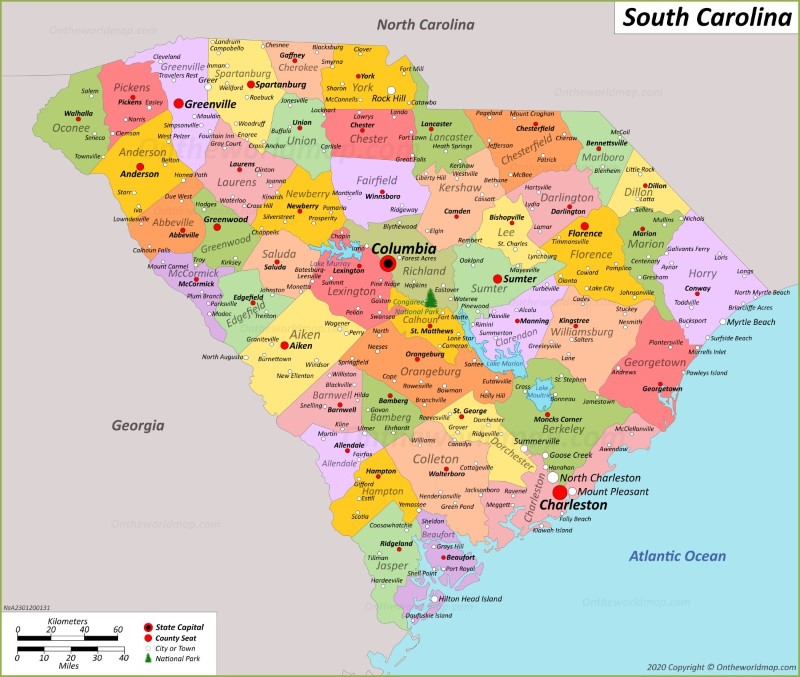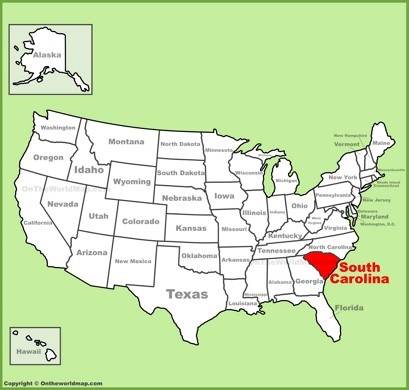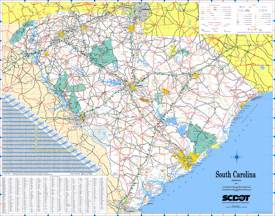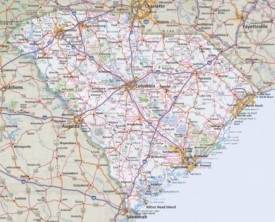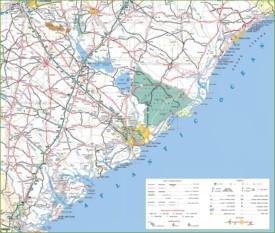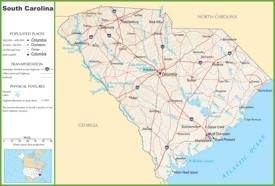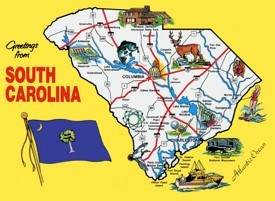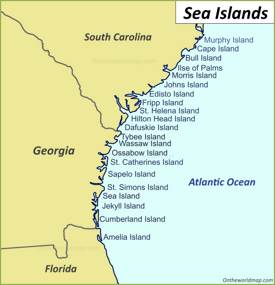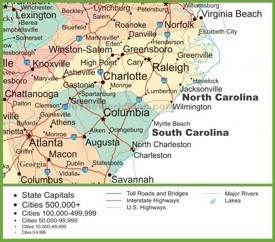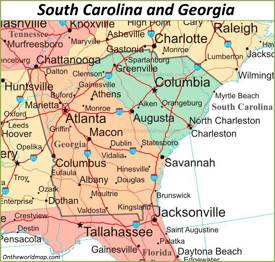South Carolina Map
Description:
This map shows states boundaries, the state capital, counties, county seats, cities, towns, islands, lakes and national parks in South Carolina.
Size: 1300x1100px / 314 Kb
Author: Ontheworldmap.com
You may download, print or use the above map for educational, personal and non-commercial purposes. Attribution is required. For any website, blog, scientific research or e-book, you must place a hyperlink (to this page) with an attribution next to the image used.
South Carolina Location Map
Online Map of South Carolina
Detailed Maps of South Carolina
Maps of South Carolina Regions
Maps of South Carolina and Neighbouring States
Other Maps of South Carolina
Google Map of South CarolinaOpenStreetMap
Bing Maps
USGS National Map
South Carolina National Map (National Atlas of the United States)
South Carolina State Highway Maps
About South Carolina
South Carolina, located in the Southeastern region of the United States, is bordered by North Carolina to the north, Georgia to the south and west, and the Atlantic Ocean to the east. South Carolina is the 40th-largest and 23rd-most populous U.S. state with a population of 5,373,555[1].
The state capital, the city of Columbia, serves as the central hub of political and economic activity. Columbia, which is also a university city, is home to the University of South Carolina, a major contributor to the region's educational landscape.
Charleston, South Carolina's most populous city, plays an important role in the state's tourism industry with its well-preserved architecture, heritage sites and vibrant culinary scene. Myrtle Beach, located on the east coast, attracts millions of visitors each year with its expansive sandy beaches, golf courses and entertainment centers. Greenville, located in the Upcountry region, supports a thriving arts scene and offers proximity to the Blue Ridge Mountains, increasing its appeal to residents and visitors alike.
South Carolina's climate is predominantly humid subtropical, with hot, humid summers and mild winters. Subtropical mountain climates prevail in the upland areas. The southeastern part of the state contains parts of the Sea Islands, a chain of barrier islands located along the Atlantic Ocean.
Tourism is a critical component of South Carolina's economy. The state combines historical attractions such as Fort Sumter and plantations with natural attractions such as Congaree National Park and Hilton Head Island. Kiawah Island, known for its luxury resorts and golf courses, attracts high-end tourists looking for leisure and recreation.
The Facts:

Flag of South Carolina |

Seal of South Carolina |
| Capital: | Columbia |
| Largest city: | Charleston |
| Area: | 32,020 sq mi (82,933 sq km) |
| Dimensions: |
|
| Latitude: | 32°02′ N to 35°13′ N |
| Longitude: | 78°32′ W to 83°21′ W |
| Population (2023): | 5,373,555[1] |
| Density: | 170.27/sq mi (65.74/sq km) |
| Elevation: | |
| Official language: |
|
| Spoken language:[3] |
|
| Religion:[4] |
|
| Racial/ethnic groups (2020):[5] |
|
| Median household income (2021): | $59,318[6] |
| USPS abbreviation: | SC |
| ISO 3166 code: | US-SC |
| Time zone: | UTC−05:00 (Eastern) Summer (DST) UTC−04:00 (EDT) |
| Official website: | sc.gov |
List of The Largest Cities in South Carolina by population
| Rank | City | County | Population (2022)[7] |
|---|---|---|---|
| 1 | Charleston | Charleston | 153,672 |
| 2 | Columbia | Richland | 139,698 |
| 3 | North Charleston | Charleston | 118,608 |
| 4 | Mount Pleasant | Charleston | 94,545 |
| 5 | Rock Hill | York | 75,349 |
| 6 | Greenville | Greenville | 72,310 |
| 7 | Summerville | Dorchester | 51,617 |
| 8 | Goose Creek | Berkeley | 47,618 |
| 9 | Sumter | Sumter | 42,757 |
| 10 | Greer | Greenville | 42,090 |
| 11 | Florence | Florence | 40,072 |
| 12 | Spartanburg | Spartanburg | 38,584 |
| 13 | Myrtle Beach | Horry | 38,417 |
| 14 | Hilton Head Island | Beaufort | 38,069 |
| 15 | Bluffton | Beaufort | 34,493 |
| 16 | Aiken | Aiken | 32,463 |
| 17 | Fort Mill | York | 30,940 |
| 18 | Anderson | Anderson | 29,771 |
| 19 | Conway | Horry | 27,346 |
| 20 | Mauldin | Greenville | 26,918 |
| 21 | North Augusta | Aiken | 24,379 |
| 22 | Lexington | Lexington | 23,568 |
| 23 | Simpsonville | Greenville | 23,354 |
| 24 | Easley | Pickens | 22,921 |
| 25 | Greenwood | Greenwood | 22,545 |
| 26 | Hanahan | Berkeley | 20,325 |
| 27 | North Myrtle Beach | Horry | 18,790 |
| 28 | Clemson | Pickens | 17,681 |
| 29 | West Columbia | Lexington | 17,416 |
| 30 | Port Royal | Beaufort | 14,220 |
South Carolina Beach Towns
- Seabrook Island
- Daufuskie Island
- Folly Island
- Beaufort
- Mount Pleasant
- Sullivan's Island
- Fripp Island
- Edisto Island
- Surfside Beach
- Myrtle Beach
Main sights in South Carolina
- Charleston's Historic District
- Fort Sumter
- Patriots Point Naval & Maritime Museum
- Magnolia Plantation and Gardens (Charleston)
- South Carolina State Museum
- Hilton Head Island
- Congaree National Park
- Huntington Beach State Park
- Brookgreen Gardens
- Riverbanks Zoo and Garden
- Caesars Head State Park
- Middleton Place
- Joe Riley Waterfront Park
- Boone Hall Plantation
- Columbia Museum of Art
Counties of South Carolina
The state of South Carolina, consists of 46 counties.
List of counties in South CarolinaSouth Carolina County Map

Regions of South Carolina:
List of National Parks in South Carolina
Congaree National Park
State Parks in South Carolina
Geography of South Carolina
South Carolina is characterized by a diverse geographic landscape divided into three major regions: the Coastal Plain, the Piedmont, and the Blue Ridge Mountains.
The Coastal Plain, which occupies the eastern and southeastern portions of the state, includes extensive marshes, barrier islands, and coastal beaches along the Atlantic Ocean.
The Piedmont region, located in the central part of the state, includes rolling hills and valleys characterized by clay-rich soil and significant agricultural activity. Major rivers such as the Savannah and Santee flow through this region, providing critical water resources and supporting hydropower.
The Blue Ridge Mountains, located in the northwest corner, are the smallest of the three regions, but are characterized by significant elevation changes and rugged terrain. It is home to peaks such as Sassafras Mountain, the state's highest point, so this region offers many types of outdoor recreation, including hiking and camping.
South Carolina's climate ranges from humid subtropical on the Coastal Plain to more temperate in the uplands of the Blue Ridge Mountains. Overall, South Carolina's geography is a diverse landscape supporting a variety of ecosystems and economic activities.
Islands of South Carolina
Major Rivers in South Carolina
- Pee Dee River
- Lynches River
- Enoree River
- Edisto River
- Savannah River
- Black River
- Santee River
- Wateree River
- Waccamaw River
- Ashepoo River
- Little Pee Dee River
- Broad River
- Combahee River
- Congaree River
- Four Hole Swamp
Lakes of South Carolina
- Lake Greenwood
- Lake Hartwell
- Lake Jocassee
- Lake Wateree
- Lake Bowen
- Lake Keowee
- Lake Marion
- Lake Murray
- Lake Moultrie
- Saluda Lake
- Lake Russell
- Lake Thurmond
- Lake Warren
- Lake Strom Thurmond
- Richard B. Russell Lake
Mountain Ranges
- Appalachian Mountains
- Blue Ridge Mountains
- Saluda Mountains
The 15 highest mountain peaks of South Carolina
Reference [8]- Saluda Mountains (3,564 ft / 1,086 m)
- Hickorynut Mountain (3,488 ft / 1,063 m)
- Pinnacle Mountain (3,415 ft / 1,040 m)
- Coldbranch Mountain (3,333 ft / 1,015 m)
- Slicking Mountain (3,323 ft / 1,012 m)
- Bradford Mountain (3,294 ft / 1,004 m)
- Rock Mountain (3,291 ft / 1,003 m)
- Fork Mountain (3,241 ft / 987 m)
- Caesars Head Mountain (3,215 ft / 979 m)
- Battered Rock Mountain (3,215 ft / 979 m)
- Caesars Head (3,209 ft / 978 m)
- Hogback Mountain (3,209 ft / 978 m)
- Peak 3200 ft (3,200 ft / 975 m)
- Medlin Mountain (3,143 ft / 957 m)
- Peak 3141 ft (3,141 ft / 957 m)
Brief History of South Carolina
South Carolina's history dates back to the first native inhabitants. By the time Europeans arrived, marking the end of the pre-Columbian era around 1600, the area was home to many separate Native American tribes, the largest of which were the Cherokee and Catawba. The English established the first permanent European settlement, Charles Town (now Charleston), in 1670. The colony became a major agricultural center, relying heavily on slave labor for its rice and indigo plantations.
In 1776, South Carolina declared independence from Great Britain and played an important role in the American Revolution. In 1788, the state became the eighth to ratify the U.S. Constitution. In the 19th century, South Carolina's economy depended on cotton and slavery, which led to the state becoming the first state to secede from the Union in 1860, triggering the Civil War.
Postwar Reconstruction was accompanied by political and social upheaval. The 20th century brought industrialization and the civil rights movement, which helped transform modern South Carolina into a diverse and economically strong state.
Page Navigation
References
1. ^ "QuickFacts: South Carolina". United States Census Bureau.2. ^ "Elevations and Distances in the United States". United States Geological Survey.
3. ^ Language Spoken at Home 2017-2021. South Carolina Revenue and Fiscal Affairs Office.
4. ^ "American Values Atlas: Religious Tradition in South Carolina". Public Religion Research Institute.
5. ^ 2020 United States census. United States Census Bureau.
6. ^ "Median Annual Household Income". The Henry J. Kaiser Family Foundation.
7. ^ "South Carolina Cities by Population". South Carolina Demographics.
8. ^ South Carolina mountains. Peakery.com
U.S. Maps
Cities of USA
States of USA
States of USA

